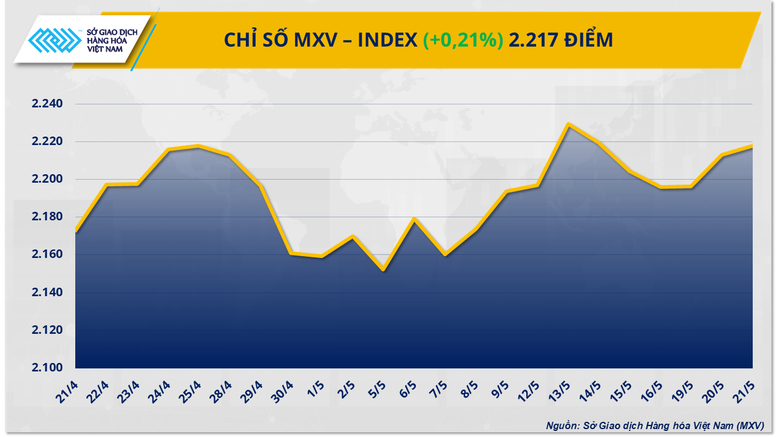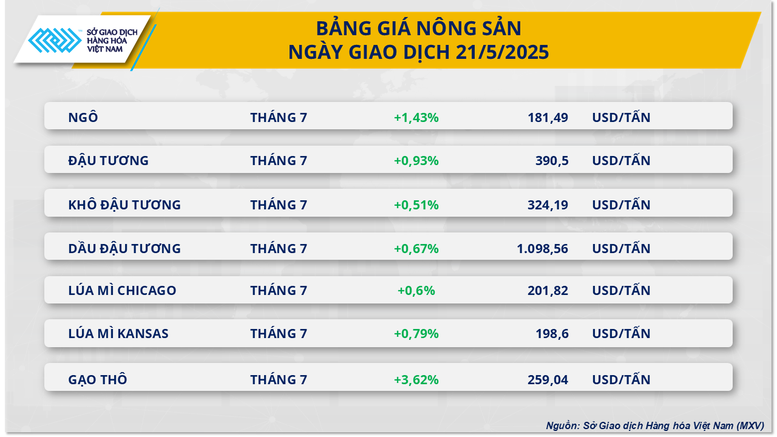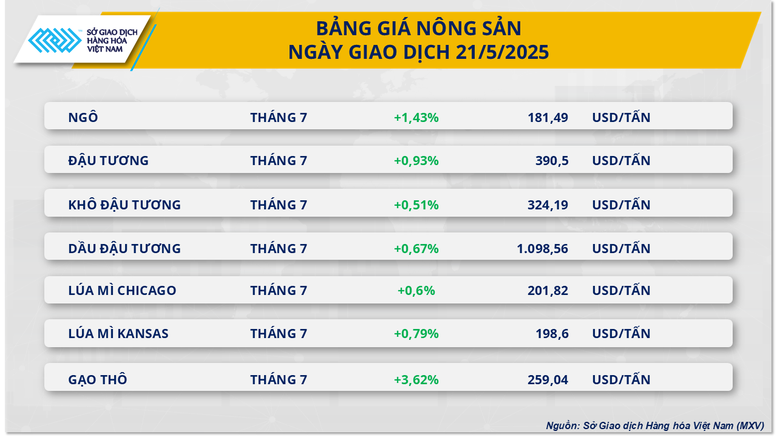
Argentina drops tax incentives on soybeans
At the end of the trading session on May 21, the positive sentiment continued to be maintained in the agricultural market with green covering the whole market. In particular, soybean prices continued to increase for the third consecutive session when they increased by 0.93% to 390 USD/ton. This increase mainly came from concerns about the decrease in supply in major producing countries.
The main impetus came from Argentina's confirmation that it would not extend its preferential tariff policy on corn, soybeans and related products, which will increase the export tax on raw soybeans to 33% from July 1, and soybean meal and oil to 31%. This decision is expected to significantly affect global supplies, especially since Argentina is one of the world's largest exporters of soybean meal.

On the weather front, in the U.S., cool and wet conditions in the Midwest this week could cause short-term delays to planting, although overall crop progress remains above historical average. Heavy rains are forecast to affect Missouri and spread southward next week, while the Midwest should be drier. If these conditions persist and are accompanied by high temperatures, supply concerns could increase, further supporting soybean prices.
On the other hand, the rise in soybean prices was capped by strong exports from Brazil, indicating that supplies remain ample. According to the Brazilian Grain Exporters Association (ANEC), the country’s soybean exports in May are expected to reach 14.5 million tons, up from last week’s estimate of 14.2 million tons.
For soybean products, both oil and meal posted modest gains. Soybean oil was supported by expectations of the 45Z biofuel credit, despite a return to lower energy prices. Meanwhile, soybean meal prices rose on supply concerns in Argentina, where heavy rains in key production areas could disrupt processing, boosting buying in the market.

Energy price list in red
According to MXV, the energy market was deep in red yesterday. Oil prices continued to decrease slightly yesterday, when positive signals about US-Iran relations appeared.
At the end of the trading session, Brent oil price recorded a decrease of 0.72%, down to 64.91 USD/barrel. WTI oil price also fell to 61.57 USD/barrel, corresponding to a decrease of about 1.58%.
At the same time, the market was also under pressure when the US Energy Information Administration (EIA) announced commercial crude oil reserves in the US. Accordingly, similar to the estimate of an increase of about 2.5 million barrels announced by the American Petroleum Institute (API) on May 20, EIA data also showed an increase of about 1.33 million barrels in commercial crude oil reserves in the working week ending on May 16, contrary to the majority of market forecasts for a decrease of between 900,000 barrels and 1.3 million barrels, bringing crude oil reserves to 443.2 million barrels.
The forecasts were made in anticipation of increased demand in the US as the peak travel season approaches. However, not only crude oil but also other related commodities, especially gasoline, recorded increased inventories last week, raising concerns about future demand in the US and putting downward pressure on oil prices.
Source: https://baochinhphu.vn/dien-bien-giang-co-mxv-index-dong-cua-tren-muc-2217-diem-102250522092302507.htm


![[Photo] Determining the pairs in the team semi-finals of the National Table Tennis Championship of Nhan Dan Newspaper](https://vphoto.vietnam.vn/thumb/1200x675/vietnam/resource/IMAGE/2025/5/21/eacbf7ae6a59497e9ae5da8e63d227bf)
![[Photo] Prime Minister Pham Minh Chinh attends the groundbreaking ceremony of Trump International Hung Yen Project](https://vphoto.vietnam.vn/thumb/1200x675/vietnam/resource/IMAGE/2025/5/21/ca84b87a74da4cddb2992a86966284cf)
![[Photo] General Secretary To Lam works with the Central Inspection Commission](https://vphoto.vietnam.vn/thumb/1200x675/vietnam/resource/IMAGE/2025/5/22/54820e91fd124c4cb691961718c4ee5d)



























































































Comment (0)